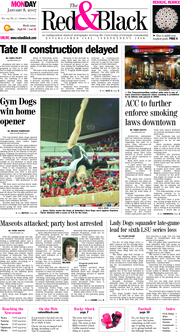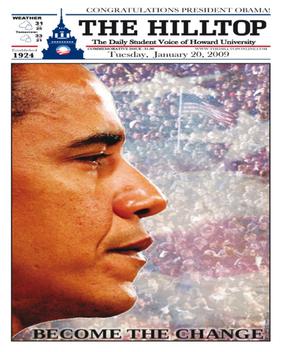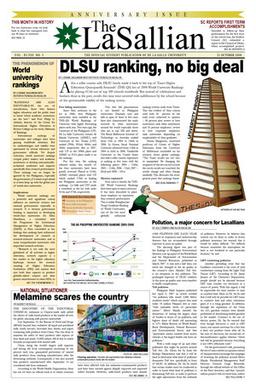The Daily Illini, commonly known as the DI, is a student-run newspaper that has been published for the community of the University of Illinois Urbana-Champaign since 1871. Weekday circulation during fall and spring semesters is 7,000; copies are distributed free at more than 100 locations throughout Champaign–Urbana.

The Peak is the independent student newspaper of Simon Fraser University in Burnaby, British Columbia, Canada. It is split into six major sections: News, Opinions, Features, Arts, Sports, and Humour.
The South End is the official student newspaper of Wayne State University in Detroit, Michigan, published in print and online. It was founded in 1967, and its publication is funded partly from university funds and partly from advertising revenues. It is distributed free of charge.

The Daily Cardinal is a student newspaper that serves the University of Wisconsin–Madison community. One of the oldest student newspapers in the country, it began publishing on Monday, April 4, 1892. The newspaper is financially and editorially independent of the university.

The Maneater is the official, editorially independent student news publication of the University of Missouri. The Maneater editorial and advertising staffs are composed entirely of students, with the exception of a professional business adviser. Financially, The Maneater is a non-profit publication funded by advertisers. The newspaper is distributed free of charge, and all aspects of its website remain accessible at no cost to readers. The editorial department of The Maneater remains independent from any student governments and organizations, as well as the Missouri School of Journalism and university itself.
The Minnesota Daily is the campus newspaper of the University of Minnesota, published Monday and Thursday while school is in session, and published weekly on Wednesdays during summer sessions. Published since 1900, the paper is currently the largest student-run and student-written newspaper in the United States and the largest paper in the state of Minnesota behind the Minneapolis Star Tribune and the St. Paul Pioneer Press. The Daily was named best daily college newspaper in the United States in 2009 and 2010 by the Society of Professional Journalists. The paper is independent from the University, but receives $500,000 worth of student service fees funding.

The Hoya, founded in 1920, is the oldest and largest student newspaper of Georgetown University in Washington, D.C., serving as the university’s newspaper of record. The Hoya is a student-run paper that prints every Friday and publishes online daily throughout the year, with a print circulation of 4,000 during the academic year. The newspaper has four main editorial sections: News, Opinion, Science, Sports and The Guide, a weekly arts and lifestyle magazine. It also publishes several annual special issues including a New Student Guide, a basketball preview and a semesterly fashion issue.
The State Press is the independent, student-operated news publication of Arizona State University. In August 2014, it became an all-digital publication. It published a free newspaper every weekday until January 2013, at which point its print distribution was reduced to once per week. The editorial board announced that ASU Student Media will begin to focus on "a host of new digital products and special print products."
The Fairfield Mirror is the student newspaper of Fairfield University in Fairfield, Connecticut. It is a student-run publication that publishes weekly on Wednesdays during the academic year with additional issues during commencement and orientation. The Mirror staff has won numerous Excellence in Journalism Awards from the Connecticut Society of Professional Journalists.
The Daily Targum is the official student newspaper of Rutgers, the State University of New Jersey. Founded in 1867, it is the second-oldest collegiate newspaper in the United States. The Daily Targum is student written and managed, and boasts a circulation of 5,000 in 2017. In its current form, it exists as a bi-fold tabloid-style paper featuring international, national, local, and university news, as well as editorials, columns, comics, classifieds, sports, and other amusements. In 1980, the paper achieved independence from the University, establishing a non-profit organization, the Targum Publishing Company, which now oversees all areas of the paper. The Daily Targum is published Monday through Friday while classes are in session, in New Brunswick, New Jersey.

The Red & Black is an independent weekly student newspaper serving the University of Georgia (UGA), updated daily on its website.
Portland State Vanguard, formerly known as the Daily Vanguard and Vet's Extended, is an independent student newspaper for Portland State University, in Portland, Oregon, United States.

The Cavalier Daily is an independent, student-run daily news organization at the University of Virginia. Founded in 1890, under the name College Topics, The Cavalier Daily is Virginia's oldest collegiate daily and the oldest daily newspaper in Charlottesville, Virginia.

Palatinate is the student newspaper of Durham University. One of Britain's oldest student publications, Palatinate is frequently ranked as one of the leading student outlets in the UK and Ireland, winning Best Publication in the Student Publication Association's 2018 and 2021 national awards. In the same year Palatinate was Highly Commended in the Best Publication category of the BBC Radio 4 Today Programme's Student Journalism Awards. Several of its editors have gone on to gain national recognition in journalism.

The Hilltop is the student newspaper of Howard University, a historically black college located in Washington, D.C. Co-founded in 1924 by Harlem Renaissance writer Zora Neale Hurston and Louis Eugene King, The Hilltop is the first and only daily newspaper at a historically black college or university (HBCU) in the United States.
The Daily Evergreen is the student newspaper for Washington State University.

The LaSallian (TLS) is the official student publication of De La Salle University, founded in 1960. It is an English language newspaper, released every first week of every month from September to August, and is run entirely by undergraduate students of DLSU Manila.

The Spectator is a biweekly high school newspaper published by students of New York City's Stuyvesant High School. The paper, founded in 1915, is one of Stuyvesant's oldest publications. It has a long-standing connection with its older namesake, Columbia University's Columbia Daily Spectator, and it has been recognized by the Columbia University Graduate School of Journalism's Columbia Scholastic Press Association on several occasions. The Spectator's original reporting has been cited by The New York Times and the Associated Press.
The Montana Kaimin is the University of Montana's student-run independent newspaper located in Missoula, Montana. The paper is printed once a week, Thursday, with special editions printed occasionally and is online at MontanaKaimin.com. The Kaimin covers news, sports, arts and culture, and opinion.
The Chicago Maroon, the independent student newspaper of the University of Chicago, is a weekly publication founded in 1892. During the academic year, The Maroon publishes every Tuesday and Friday. The paper consists of seven sections: news, opinion ("Viewpoints"), arts, sports, Grey City, podcasts, and games. In September, it publishes its annual orientation Issue (O-Issue) for entering first-year students, including sections on the University and the city of Chicago.










